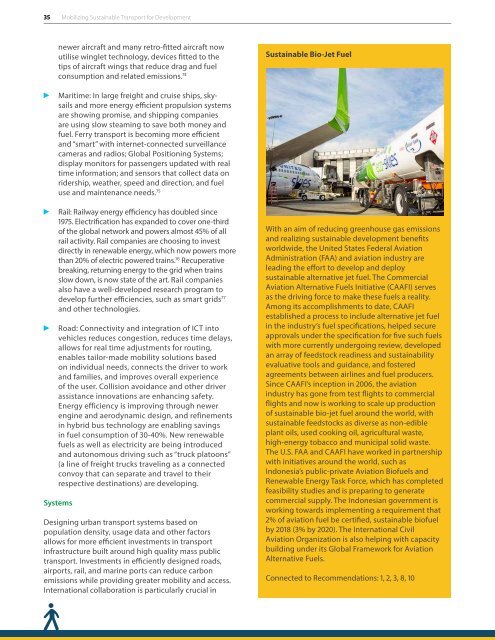MOBILIZING DEVELOPMENT
a5OQ306q56U
a5OQ306q56U
Create successful ePaper yourself
Turn your PDF publications into a flip-book with our unique Google optimized e-Paper software.
35 Mobilizing Sustainable Transport for Development<br />
newer aircraft and many retro-fitted aircraft now<br />
utilise winglet technology, devices fitted to the<br />
tips of aircraft wings that reduce drag and fuel<br />
consumption and related emissions. 74<br />
Sustainable Bio-Jet Fuel<br />
Maritime: In large freight and cruise ships, skysails<br />
and more energy efficient propulsion systems<br />
are showing promise, and shipping companies<br />
are using slow steaming to save both money and<br />
fuel. Ferry transport is becoming more efficient<br />
and “smart” with internet-connected surveillance<br />
cameras and radios; Global Positioning Systems;<br />
display monitors for passengers updated with real<br />
time information; and sensors that collect data on<br />
ridership, weather, speed and direction, and fuel<br />
use and maintenance needs. 75<br />
Rail: Railway energy efficiency has doubled since<br />
1975. Electrification has expanded to cover one-third<br />
of the global network and powers almost 45% of all<br />
rail activity. Rail companies are choosing to invest<br />
directly in renewable energy, which now powers more<br />
than 20% of electric powered trains. 76 Recuperative<br />
breaking, returning energy to the grid when trains<br />
slow down, is now state of the art. Rail companies<br />
also have a well-developed research program to<br />
develop further efficiencies, such as smart grids 77<br />
and other technologies.<br />
Road: Connectivity and integration of ICT into<br />
vehicles reduces congestion, reduces time delays,<br />
allows for real time adjustments for routing,<br />
enables tailor-made mobility solutions based<br />
on individual needs, connects the driver to work<br />
and families, and improves overall experience<br />
of the user. Collision avoidance and other driver<br />
assistance innovations are enhancing safety.<br />
Energy efficiency is improving through newer<br />
engine and aerodynamic design, and refinements<br />
in hybrid bus technology are enabling savings<br />
in fuel consumption of 30-40%. New renewable<br />
fuels as well as electricity are being introduced<br />
and autonomous driving such as “truck platoons”<br />
(a line of freight trucks traveling as a connected<br />
convoy that can separate and travel to their<br />
respective destinations) are developing.<br />
Systems<br />
Designing urban transport systems based on<br />
population density, usage data and other factors<br />
allows for more efficient investments in transport<br />
infrastructure built around high quality mass public<br />
transport. Investments in efficiently designed roads,<br />
airports, rail, and marine ports can reduce carbon<br />
emissions while providing greater mobility and access.<br />
International collaboration is particularly crucial in<br />
With an aim of reducing greenhouse gas emissions<br />
and realizing sustainable development benefits<br />
worldwide, the United States Federal Aviation<br />
Administration (FAA) and aviation industry are<br />
leading the effort to develop and deploy<br />
sustainable alternative jet fuel. The Commercial<br />
Aviation Alternative Fuels Initiative (CAAFI) serves<br />
as the driving force to make these fuels a reality.<br />
Among its accomplishments to date, CAAFI<br />
established a process to include alternative jet fuel<br />
in the industry’s fuel specifications, helped secure<br />
approvals under the specification for five such fuels<br />
with more currently undergoing review, developed<br />
an array of feedstock readiness and sustainability<br />
evaluative tools and guidance, and fostered<br />
agreements between airlines and fuel producers.<br />
Since CAAFI’s inception in 2006, the aviation<br />
industry has gone from test flights to commercial<br />
flights and now is working to scale up production<br />
of sustainable bio-jet fuel around the world, with<br />
sustainable feedstocks as diverse as non-edible<br />
plant oils, used cooking oil, agricultural waste,<br />
high-energy tobacco and municipal solid waste.<br />
The U.S. FAA and CAAFI have worked in partnership<br />
with initiatives around the world, such as<br />
Indonesia’s public-private Aviation Biofuels and<br />
Renewable Energy Task Force, which has completed<br />
feasibility studies and is preparing to generate<br />
commercial supply. The Indonesian government is<br />
working towards implementing a requirement that<br />
2% of aviation fuel be certified, sustainable biofuel<br />
by 2018 (3% by 2020). The International Civil<br />
Aviation Organization is also helping with capacity<br />
building under its Global Framework for Aviation<br />
Alternative Fuels.<br />
Connected to Recommendations: 1, 2, 3, 8, 10


